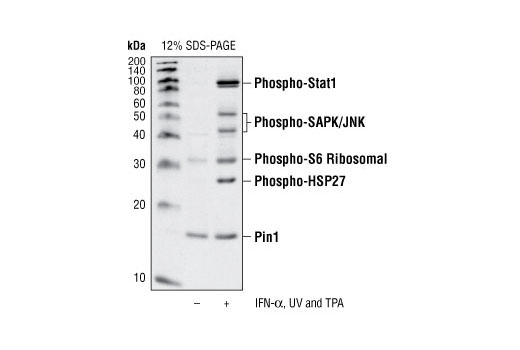WB
H
Endogenous
Rabbit
#P45983, #P53779, #Q13526, #P04792, #P62753, #P42224
5599, 5602, 5300, 3315, 6194, 6772
Product Information
Storage
Specificity / Sensitivity
Species Reactivity:
Human
Source / Purification
Antibodies are produced by immunizing animals with synthetic peptides. Polyclonal antibodies are purified by protein A and peptide affinity chromatography.
Product Description
Background
Stat1, while activated in response to a large number of ligands, appears to be essential for responsiveness to IFN-alpha and IFN-gamma (1-3).
Phosphorylation of Stat1 at Tyr701 induces Stat1 dimerization, nuclear translocation and DNA binding (4). Stat1 has been found to be inappropriately activated in many tumors (5).
The stress-activated protein kinase/Jun-terminal kinase SAPK/JNK is potently and preferentially activated by a variety of environmental stresses, including UV and gamma radiation, ceramides, inflammatory cytokines and, in some instances, by growth factors and GPCR agonists (6,7). SAPK/JNK, when active as a dimer, can translocate to the nucleus where it regulates transcription through its effects on c-Jun, ATF-2 and other transcription factors (8).
To effectively promote growth and cell division in a sustained manner, growth factors and mitogens must upregulate translation (9,10). Growth factors and mitogens induce the activation of p70 S6 kinase, which in turn phosphorylate the S6 ribosomal protein. Phosphorylation of S6 correlates with an increase in translation, particularly of mRNAs with an oligopyrimidine tract in their 5' untranslated regions (10). This group of mRNAs (5'TOP) encodes proteins involved in cell cycle progression and proteins that are part of the translational machinery, such as ribosomal proteins and elongation factors (10,11).
Heat shock protein (HSP) 27 is one of the small HSPs, regulated at both the transcriptional and posttranslational levels (12). In response to stress, the expression level of HSP27 increases several-fold to confer cellular resistance to the adverse environmental change. HSP27 is also phosphorylated at serines 15, 78 and 82 by MAPKAP kinase 2 as a result of p38 MAP kinase pathway activation (13,14).
- Heim, M.H. (1999) J. Recept. Signal. Transduct. Res. 19, 75-120.
- Durbin, J.E. et al. (1996) Cell 84, 443-450.
- Meraz, M.A. et al. (1996) Cell 84, 431-442.
- Ihle, J.N. et al. (1994) Trends Biochem. Sci. 19, 222-227.
- Frank, D.A. (1999) Mol. Med. 5, 432-456.
- Davis, R.J. (1999) Biochem. Soc. Symp. 64, 1-12.
- Kyriakis, J.M. and Avruch, J. (2001) Phisiol. Rev. 81, 807-869.
- Whitmarsh, A.J. and Davis, R.J. (1998) Trends Biochem. Sci. 23, 481-485.
- Dufner, A. and Thomas, G. (1999) Exp. Cell. Res. 253, 100-109.
- Peterson, R.T. and Schreiber, S.L. (1998) Curr. Biol. 8, R248-R250.
- Jefferies, H.B. et al. (1997) EMBO J 16, 3693-704.
- Arrigo, A.P. and Landry, J. (1994) The Biology of Heat Shock Proteins and Molecular Chaperones. Cold Spring Harbor Laboratory Press, NY 335-373.
- Landry, J. et al. (1992) J. Biol. Chem. 267, 794-803.
- Rouse, J. et al. (1994) Cell 78, 1027-1037.
Species Reactivity
Species reactivity is determined by testing in at least one approved application (e.g., western blot).
Western Blot Buffer
IMPORTANT: For western blots, incubate membrane with diluted primary antibody in 5% w/v BSA, 1X TBS, 0.1% Tween® 20 at 4°C with gentle shaking, overnight.
Applications Key
WB: Western Blotting
Cross-Reactivity Key
H: human M: mouse R: rat Hm: hamster Mk: monkey Vir: virus Mi: mink C: chicken Dm: D. melanogaster X: Xenopus Z: zebrafish B: bovine Dg: dog Pg: pig Sc: S. cerevisiae Ce: C. elegans Hr: horse GP: Guinea Pig Rab: rabbit All: all species expected
Trademarks and Patents
Limited Uses
Except as otherwise expressly agreed in a writing signed by a legally authorized representative of CST, the following terms apply to Products provided by CST, its affiliates or its distributors. Any Customer's terms and conditions that are in addition to, or different from, those contained herein, unless separately accepted in writing by a legally authorized representative of CST, are rejected and are of no force or effect.
Products are labeled with For Research Use Only or a similar labeling statement and have not been approved, cleared, or licensed by the FDA or other regulatory foreign or domestic entity, for any purpose. Customer shall not use any Product for any diagnostic or therapeutic purpose, or otherwise in any manner that conflicts with its labeling statement. Products sold or licensed by CST are provided for Customer as the end-user and solely for research and development uses. Any use of Product for diagnostic, prophylactic or therapeutic purposes, or any purchase of Product for resale (alone or as a component) or other commercial purpose, requires a separate license from CST. Customer shall (a) not sell, license, loan, donate or otherwise transfer or make available any Product to any third party, whether alone or in combination with other materials, or use the Products to manufacture any commercial products, (b) not copy, modify, reverse engineer, decompile, disassemble or otherwise attempt to discover the underlying structure or technology of the Products, or use the Products for the purpose of developing any products or services that would compete with CST products or services, (c) not alter or remove from the Products any trademarks, trade names, logos, patent or copyright notices or markings, (d) use the Products solely in accordance with CST Product Terms of Sale and any applicable documentation, and (e) comply with any license, terms of service or similar agreement with respect to any third party products or services used by Customer in connection with the Products.
